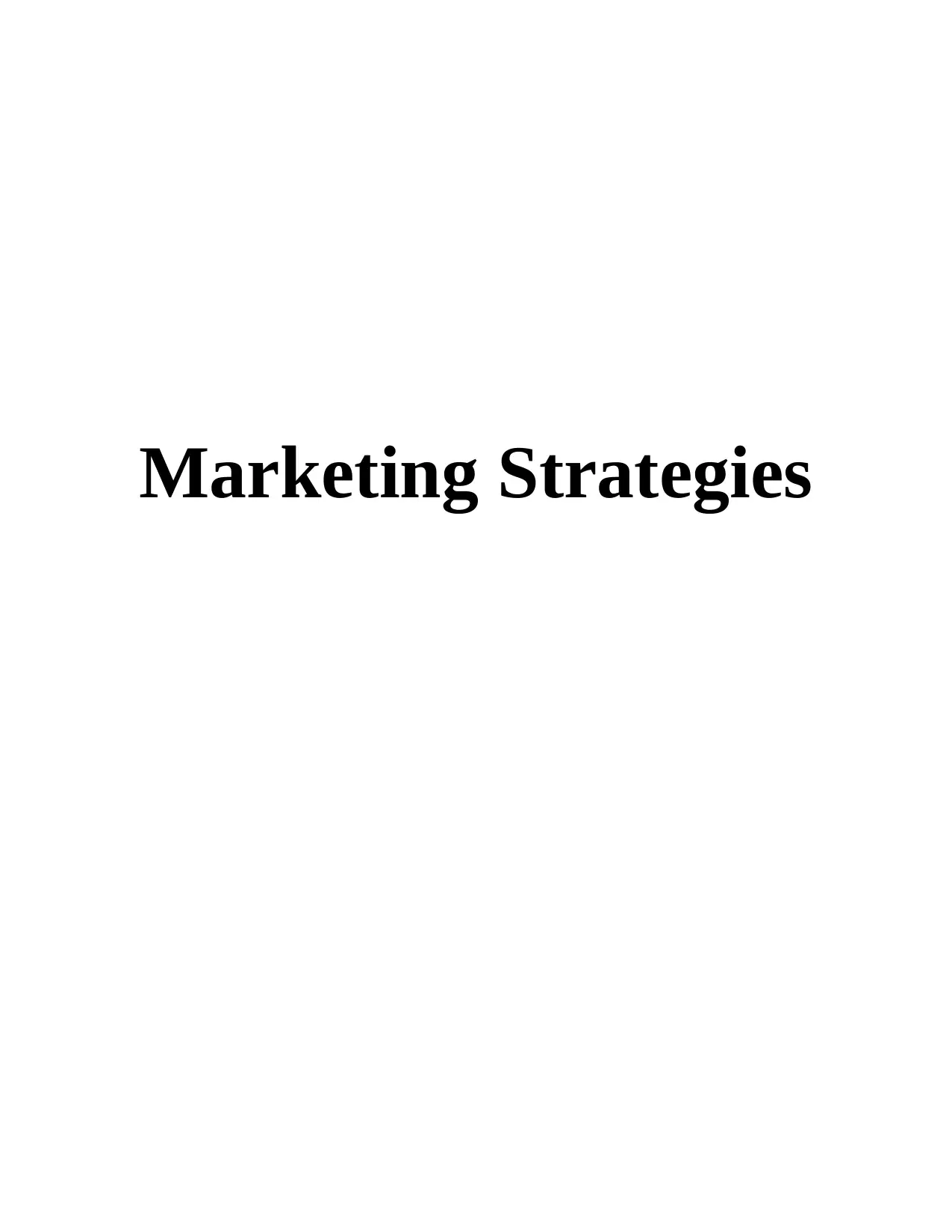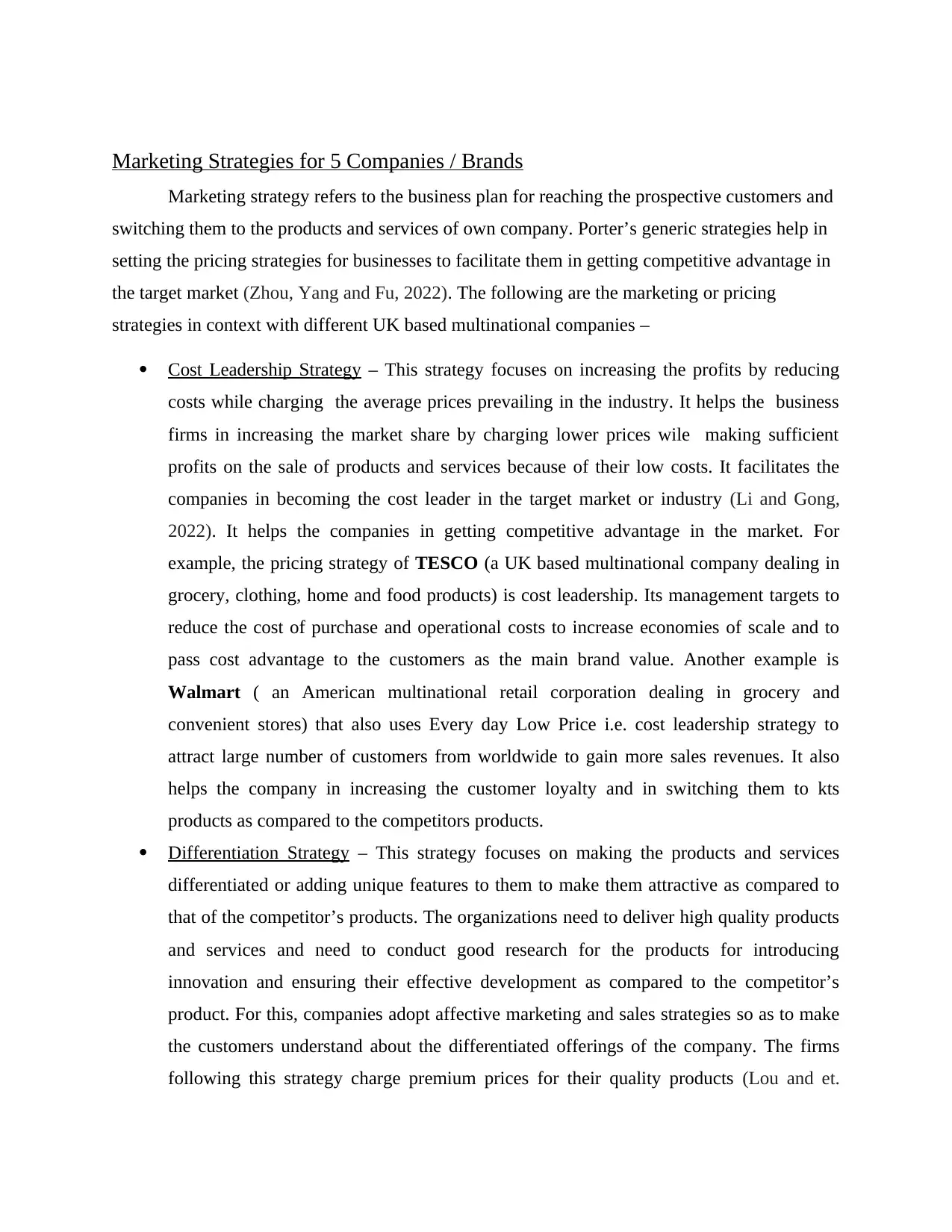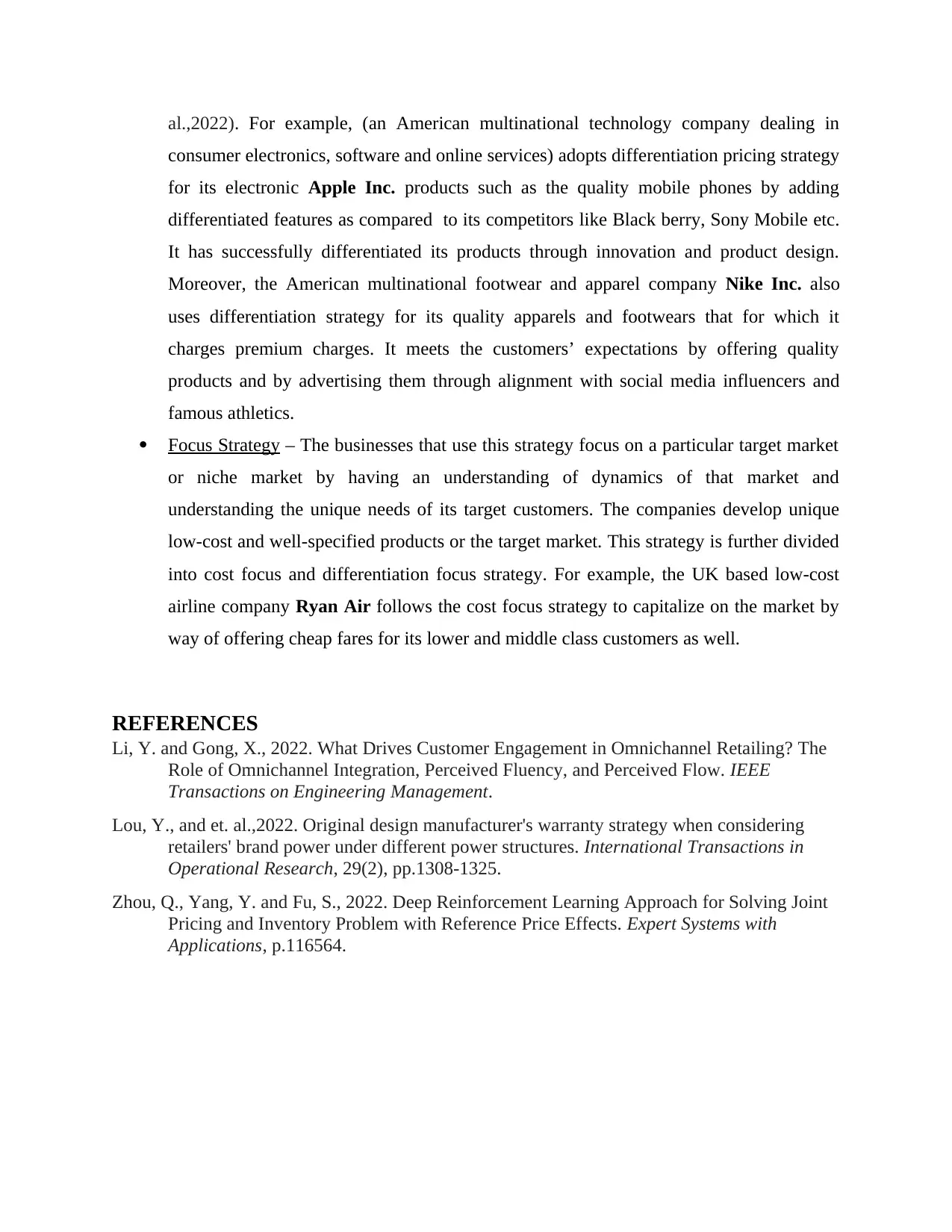Marketing Strategies: Analysis of UK Multinational Companies
VerifiedAdded on 2023/06/10
|3
|750
|203
Report
AI Summary
This report examines the marketing strategies employed by five UK-based multinational companies. It delves into Porter's generic strategies, specifically cost leadership, differentiation, and focus strategies, and how these are applied in real-world scenarios. The report provides examples of how companies like Tesco, Apple, Nike, and Ryan Air utilize these strategies to gain a competitive advantage. The analysis includes how these companies set their pricing strategies to attract customers, increase market share, and build brand loyalty. The report also highlights the importance of innovation, product differentiation, and understanding target market dynamics in the formulation of effective marketing plans. The report provides references to academic research to support its claims.

Marketing Strategies
Paraphrase This Document
Need a fresh take? Get an instant paraphrase of this document with our AI Paraphraser

Marketing Strategies for 5 Companies / Brands
Marketing strategy refers to the business plan for reaching the prospective customers and
switching them to the products and services of own company. Porter’s generic strategies help in
setting the pricing strategies for businesses to facilitate them in getting competitive advantage in
the target market (Zhou, Yang and Fu, 2022). The following are the marketing or pricing
strategies in context with different UK based multinational companies –
Cost Leadership Strategy – This strategy focuses on increasing the profits by reducing
costs while charging the average prices prevailing in the industry. It helps the business
firms in increasing the market share by charging lower prices wile making sufficient
profits on the sale of products and services because of their low costs. It facilitates the
companies in becoming the cost leader in the target market or industry (Li and Gong,
2022). It helps the companies in getting competitive advantage in the market. For
example, the pricing strategy of TESCO (a UK based multinational company dealing in
grocery, clothing, home and food products) is cost leadership. Its management targets to
reduce the cost of purchase and operational costs to increase economies of scale and to
pass cost advantage to the customers as the main brand value. Another example is
Walmart ( an American multinational retail corporation dealing in grocery and
convenient stores) that also uses Every day Low Price i.e. cost leadership strategy to
attract large number of customers from worldwide to gain more sales revenues. It also
helps the company in increasing the customer loyalty and in switching them to kts
products as compared to the competitors products.
Differentiation Strategy – This strategy focuses on making the products and services
differentiated or adding unique features to them to make them attractive as compared to
that of the competitor’s products. The organizations need to deliver high quality products
and services and need to conduct good research for the products for introducing
innovation and ensuring their effective development as compared to the competitor’s
product. For this, companies adopt affective marketing and sales strategies so as to make
the customers understand about the differentiated offerings of the company. The firms
following this strategy charge premium prices for their quality products (Lou and et.
Marketing strategy refers to the business plan for reaching the prospective customers and
switching them to the products and services of own company. Porter’s generic strategies help in
setting the pricing strategies for businesses to facilitate them in getting competitive advantage in
the target market (Zhou, Yang and Fu, 2022). The following are the marketing or pricing
strategies in context with different UK based multinational companies –
Cost Leadership Strategy – This strategy focuses on increasing the profits by reducing
costs while charging the average prices prevailing in the industry. It helps the business
firms in increasing the market share by charging lower prices wile making sufficient
profits on the sale of products and services because of their low costs. It facilitates the
companies in becoming the cost leader in the target market or industry (Li and Gong,
2022). It helps the companies in getting competitive advantage in the market. For
example, the pricing strategy of TESCO (a UK based multinational company dealing in
grocery, clothing, home and food products) is cost leadership. Its management targets to
reduce the cost of purchase and operational costs to increase economies of scale and to
pass cost advantage to the customers as the main brand value. Another example is
Walmart ( an American multinational retail corporation dealing in grocery and
convenient stores) that also uses Every day Low Price i.e. cost leadership strategy to
attract large number of customers from worldwide to gain more sales revenues. It also
helps the company in increasing the customer loyalty and in switching them to kts
products as compared to the competitors products.
Differentiation Strategy – This strategy focuses on making the products and services
differentiated or adding unique features to them to make them attractive as compared to
that of the competitor’s products. The organizations need to deliver high quality products
and services and need to conduct good research for the products for introducing
innovation and ensuring their effective development as compared to the competitor’s
product. For this, companies adopt affective marketing and sales strategies so as to make
the customers understand about the differentiated offerings of the company. The firms
following this strategy charge premium prices for their quality products (Lou and et.

al.,2022). For example, (an American multinational technology company dealing in
consumer electronics, software and online services) adopts differentiation pricing strategy
for its electronic Apple Inc. products such as the quality mobile phones by adding
differentiated features as compared to its competitors like Black berry, Sony Mobile etc.
It has successfully differentiated its products through innovation and product design.
Moreover, the American multinational footwear and apparel company Nike Inc. also
uses differentiation strategy for its quality apparels and footwears that for which it
charges premium charges. It meets the customers’ expectations by offering quality
products and by advertising them through alignment with social media influencers and
famous athletics.
Focus Strategy – The businesses that use this strategy focus on a particular target market
or niche market by having an understanding of dynamics of that market and
understanding the unique needs of its target customers. The companies develop unique
low-cost and well-specified products or the target market. This strategy is further divided
into cost focus and differentiation focus strategy. For example, the UK based low-cost
airline company Ryan Air follows the cost focus strategy to capitalize on the market by
way of offering cheap fares for its lower and middle class customers as well.
REFERENCES
Li, Y. and Gong, X., 2022. What Drives Customer Engagement in Omnichannel Retailing? The
Role of Omnichannel Integration, Perceived Fluency, and Perceived Flow. IEEE
Transactions on Engineering Management.
Lou, Y., and et. al.,2022. Original design manufacturer's warranty strategy when considering
retailers' brand power under different power structures. International Transactions in
Operational Research, 29(2), pp.1308-1325.
Zhou, Q., Yang, Y. and Fu, S., 2022. Deep Reinforcement Learning Approach for Solving Joint
Pricing and Inventory Problem with Reference Price Effects. Expert Systems with
Applications, p.116564.
consumer electronics, software and online services) adopts differentiation pricing strategy
for its electronic Apple Inc. products such as the quality mobile phones by adding
differentiated features as compared to its competitors like Black berry, Sony Mobile etc.
It has successfully differentiated its products through innovation and product design.
Moreover, the American multinational footwear and apparel company Nike Inc. also
uses differentiation strategy for its quality apparels and footwears that for which it
charges premium charges. It meets the customers’ expectations by offering quality
products and by advertising them through alignment with social media influencers and
famous athletics.
Focus Strategy – The businesses that use this strategy focus on a particular target market
or niche market by having an understanding of dynamics of that market and
understanding the unique needs of its target customers. The companies develop unique
low-cost and well-specified products or the target market. This strategy is further divided
into cost focus and differentiation focus strategy. For example, the UK based low-cost
airline company Ryan Air follows the cost focus strategy to capitalize on the market by
way of offering cheap fares for its lower and middle class customers as well.
REFERENCES
Li, Y. and Gong, X., 2022. What Drives Customer Engagement in Omnichannel Retailing? The
Role of Omnichannel Integration, Perceived Fluency, and Perceived Flow. IEEE
Transactions on Engineering Management.
Lou, Y., and et. al.,2022. Original design manufacturer's warranty strategy when considering
retailers' brand power under different power structures. International Transactions in
Operational Research, 29(2), pp.1308-1325.
Zhou, Q., Yang, Y. and Fu, S., 2022. Deep Reinforcement Learning Approach for Solving Joint
Pricing and Inventory Problem with Reference Price Effects. Expert Systems with
Applications, p.116564.
⊘ This is a preview!⊘
Do you want full access?
Subscribe today to unlock all pages.

Trusted by 1+ million students worldwide
1 out of 3
Related Documents
Your All-in-One AI-Powered Toolkit for Academic Success.
+13062052269
info@desklib.com
Available 24*7 on WhatsApp / Email
![[object Object]](/_next/static/media/star-bottom.7253800d.svg)
Unlock your academic potential
Copyright © 2020–2025 A2Z Services. All Rights Reserved. Developed and managed by ZUCOL.





